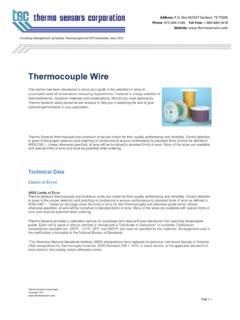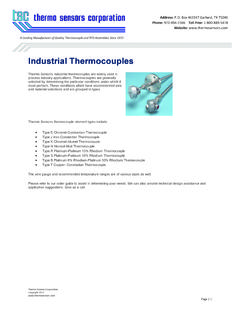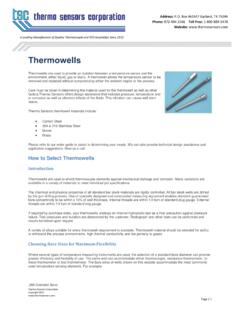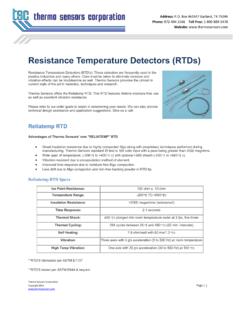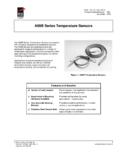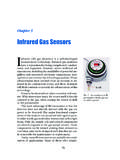Transcription of Resistance Temperature Detectors (RTDs) - …
1 Thermo Sensors Corporation Copyright 2013 Page | 1 Address: Box 461947 Garland, TX 75046 Phone: 972 -494 -1566 Toll Free: 1-800 -889 -5478 Website: Resistance Temperature Detectors ( rtds ) Resistance Temperature Detectors (RTD's). These Detectors are frequently used in the plastics industries and many others. Care must be taken to eliminate moisture and vibration effects can be troublesome as well. Thermo Sensors provides the utmost in current state of the art in materials, techniques and research. Thermo Sensors offers the Reliatemp RTD. This RTD features lifetime moisture free use as well as excellent vibration Resistance .
2 Please refer to our order guide to assist in determining your needs. We can also provide technical design assistance and application suggestions. Give us a call. Reliatemp RTD Advantages of Thermo Sensors' new "RELIATEMP" RTD Great insulation Resistance due to highly compacted Mgo along with proprietary techniques performed during manufacturing. Thermo Sensors standard IR test is 100 volts input with a pass being greater than 2000 megohms. Wide span of Temperature , (-200 to +400 c) with optional I-600 sheath (-200 to +660 c). Vibration resistant due to encapsulation method of element.
3 Improved time response due to moisture free Mgo compaction. Less drift due to Mgo compaction and iron-free backing powder in RTD tip. Reliatemp RTD Specs Ice Point Resistance : 100 ohm .10 ohm Temperature Range: -200 TO +660 c Insulation Resistance : >2000 megaohms (waterproof) Time Response: seconds Thermal Shock: 450 c plunged into room Temperature water at 3 fps, five times Thermal Cycling: 284 cycles between 26 and 480 c (62 min. intervals) Self Heating: ohm/watt with 60 c Vibration: Three axes with 3 g's acceleration (5 to 500 Hz) at room Temperature High Temp Vibration: One axis with 20 g's acceleration (30 to 550 Hz) at 540 c **RTD'S fabricated per ASTM E1137 **RTD'S tested per ASTM E644 & beyond Thermo Sensors Corporation Copyright 2013 Page | 2 Address: Box 461947 Garland, TX 75046 Phone: 972 -494 -1566 Toll Free: 1-800 -889 -5478 Website: Reliatemp RTD Warranty Thermo Sensors warrants all RTD's to be free from defects in workmanship for a three year period.
4 This warranty is limited to workmanship in the encapsulation process. RTD's which fail within the three year period due to vibration, physical abuse or process, will not be covered under warranty. Thermo sensor 's Reliatemp RTD is completely waterproof. Therefore, insulation Resistance is guaranteed for a lifetime to be moisture free, greater than 2000 megohms. Rtd's which "fall within" the warranty conditions will be replaced at no charge, after the Thermo Sensors evaluation. Introduction For years Thermo Sensors Corporation has been furnishing quality RTD's used to control industrial processes worldwide.
5 Being genuinely dedicated to furnishing materials to current state-of-the-art techniques; Thermo Sensors Corporation is constantly striving for innovation and improvement in all its products. An example is our development of Reliatemp, industries only lifetime moisture free RTD along with excellent vibration Resistance , solving industries two main problems. We are dedicated to continue furnishing industry with precision high quality products. The information in this section is designed to help you better understand RTD's and give ordering information in a clear and concise way. Application and Technical Data Linearity Linearity is defined as the maximum deviation of the calibration curve (an average of the upscale and downscale readings) from a straight line so positioned as to minimize the maximum deviation.
6 Platinum Resistance elements have a nearly linear output while nickel and nickel-iron (Balco) sensors are quite curved. Copper elements are also nearly linear over their narrow Temperature range. Stability Stability is the relationship of a sensor 's original Resistance curve to its curve after being in service. Drift rates published by a manufacturer must be assumed to be applicable to high purity laboratory environment probes. The published drift rates of C are to be considered general and not necessarily quantitative. Several parameters affect stability in a platinum sensor used in industrial processes.
7 Thermal and mechanical treatment cause physical changes in the crystalline structure of the platinum causing different resistances at different temperatures . Chemical reactions involving platinum and impurities as well as migration of internal materials can affect a sensor output. A shunting effect due to insulation Resistance deterioration is another influencing occurrence. The drift caused by these conditions is not normally catastrophic except in rare instances. Attempts to establish a statement of stability in industrial applications would result in an ambiguous approximation at best. Thermo Sensors Corporation Copyright 2013 Page | 3 Address: Box 461947 Garland, TX 75046 Phone: 972 -494 -1566 Toll Free: 1-800 -889 -5478 Website: Self-Heating Since an RTD measures Temperature by passing a current through a resistor (the RTD), the error known as self-heating occurs.
8 Primarily the sensor 's mass, its internal construction, the measurement current and to a large degree environmental conditions determine the magnitude of this error. Normally a very small current, usually 1-5 milliamps is used in the excitation circuit to minimize this joule heating of the sensor . Thermo Sensors' internal construction technique maximizes heat transfer quality to further reduce the effect. An installation condition requiring large mass hardware such as thermowells or protective tubes coupled with an environment of still or slow moving air is going to experience a great deal more self-heating than the next example.
9 A small diameter (.250" ) direct immersion probe mounted in an environment of flowing water (min. 3 ) could totally dissipate the error. Fortunately if a small measuring current (1-2 ma) is used, selfheating errors will be well within acceptable levels for industrial applications. To approximate the amount of error; consider that normally the dissipation constant will be of the magnitude of 20-100 mw/0 C, and use the following formula. Self-heating error = Power Dissipation constant Example: Measurement current - 2 ma Resistance of sensor - 140 ohms dissipation constant - 50 mw/0 C Power = 12 R = (.)
10 002)2 (140) = MW Error = .56 mw .011 C 50 mw/0 C Time Constant Time constants are values used to indicate the time it takes a sensor to read of a step change in Temperature . This test is conducted in water flowing at 3 ft/sec or 20 ft/sec in air. Typically this measurement is made by plunging a sensor at room Temperature into a bath at 80 C and noting the time required to reach of that step change. Generally speaking, it takes approximately five (5) time constants before 100% of the step change is realized. Several variables affect the response time of sensors. Diameter of the sheath, material of the sheath and internal construction for different Temperature ranges are the most variable.

